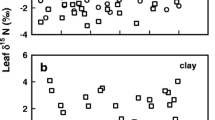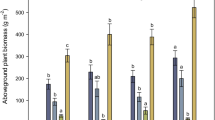Abstract
Legumes, with the ability to fix atmospheric nitrogen (N), may help alleviate the N limitations thought to constrain plant community response to elevated concentrations of atmospheric carbon dioxide (CO2). To address this issue we assessed: (1) the effects of the presence of the perennial grassland N2 fixer, Lupinus perennis, on biomass accumulation and plant N concentrations of nine-species plots of differing plant composition; (2) leaf-level physiology of co-occurring non-fixing species (Achillea millefolium, Agropyron repens, Koeleria cristata) in these assemblages with and without Lupinus; (3) the effects of elevated CO2 on Lupinus growth and symbiotic N2 fixation in both monoculture and the nine-species assemblages; and (4) whether assemblages containing Lupinus exhibit larger physiological and growth responses to elevated CO2 than those without. This study was part of a long-term grassland field experiment (BioCON) that controls atmospheric CO2 at current ambient and elevated (560 µmol mol−1) concentrations using free-air CO2 enrichment. Nine-species plots with Lupinus had 32% higher whole plot plant N concentrations and 26% higher total plant N pools than those without Lupinus, based on both above and belowground measurements. Co-occurring non-fixer leaf N concentrations increased 22% and mass-based net photosynthetic rates increased 41% in plots containing Lupinus compared to those without. With CO2 enrichment, Lupinus monocultures accumulated 32% more biomass and increased the proportion of N derived from fixation from 44% to 57%. In nine-species assemblages, Lupinus N derived from fixation increased similarly from 43% to 54%. Although Lupinus presence enhanced photosynthetic rates and leaf N concentrations of co-occurring non-fixers, and increased overall plant N pools, Lupinus presence did not facilitate stronger photosynthetic responses of non-fixing species or larger growth responses of overall plant communities to elevated CO2. Non-fixer leaf N concentrations declined similarly in response to elevated CO2 with and without Lupinus present and the relationship between net photosynthesis and leaf N was not affected by Lupinus presence. Regardless of the presence or absence of Lupinus, CO2 enrichment resulted in reduced leaf N concentrations and rates of net photosynthesis.




Similar content being viewed by others
References
Bazzaz FA, McConnaughay KDM (1992) Plant-plant interactions in elevated CO2 environments. Aust J Bot 40:547–563
Chiariello NR, Field CB (1996) Annual grassland responses to elevated CO2 in multiyear community microcosms. In: Körner C, Bazzaz FA (eds) Carbon dioxide, populations, and communities. Academic Press, San Diego, pp 139–157
Curtis PS, Wang X (1998) A meta-analysis of elevated CO2 effects on woody plant mass, form, and physiology. Oecologia 113:299–313
Díaz S, Grime JP, Harris J, McPherson E (1993) Evidence of a feedback mechanism limiting plant response to elevated carbon dioxide. Nature 364:616–617
Drake BG, Gonzàlez-Meler MA, Long SP (1997) More efficient plants: a consequence of rising atmospheric CO2? Annu Rev Plant Physiol Plant Mol Biol 48:609–639
Gifford RM (1992) Interaction of carbon dioxide with growth-limiting environmental factors in vegetation productivity: implications for the global carbon cycle. In: Gifford RM, Nilson T, Greenwood EAN (eds) Advances in bioclimatology 1. Springer, Berlin Heidelberg New York, pp 24–58
Halvorson JJ, Smith JL, Franz EH (1991) Lupine influence on soil carbon, nitrogen, and microbial activity in developing ecosystems at Mount St. Helens. Oecologia 87:162–170
Hartwig UA (1998) The regulation of symbiotic N2 fixation: a conceptual model of N feedback from the ecosystem to the gene expression level. Perspect Plant Ecol Evol Syst 1: 92–120
Hebeisen T, Lüscher A, Nösberger J (1997a) Effects of elevated atmospheric CO2 and nitrogen fertilisation on yield of Trifolium repens and Lolium perenne. Acta Oecol 18:277–284
Hebeisen T, Lüscher A, Zanetti S, Fischer BU, Hartwig UA, Frehner M, Hendrey GR, Blum H, Nösberger J (1997b) Growth response of Trifolium repens L. and Lolium perenne L. as monocultures and bi-species mixture to free air CO2 enrichment and management. Global Change Biol 3:149–160
Hector A, Schmid B, Beiekuhnlein C, Caldeira MC, Diemer M, Dimitrakopoulos, Finn JA, Freitas H, Giller PS, Good J, Harris R, Högberg P, Huss-Danell K, Joshi J, Jumpponen A, Körner C, Leadley PW, Loreau M, Minns A, Mulder CPH, O'Donovan G, Otway SJ, Pereira JS, Prinz A, Read DJ, Scherer-Lorenzen M, Schulze E-D, Siamantziouras A-SD, Spehn EM, Tery AC, Troumbis AY, Woodward FI, Yachi S, Lawton JH (1999) Plant diversity and productivity experiments in European grasslands. Science 286:1123–1127
Körner C, Bazzaz FA, Field CA (1996) The significance of biological variation, organism interactions, and life histories in CO2 research. In: Körner C, Bazzaz FA (eds) Carbon dioxide, populations, and communities. Academic Press, San Diego, pp 443–456
Körner C, Diemer M, Schäppi B, Miklaus P, Arnone J III (1997) The responses of alpine grassland to four seasons of CO2 enrichment: a synthesis. Acta Oecol 18:165–175
Leadley PW, Körner C (1996) Effects of elevated CO2 on plant species dominance in a highly diverse calcareous grassland. In: Körner C, Bazzaz FA, (eds) Carbon dioxide, populations, and communities. Academic Press, San Diego, pp 159–175
Lee TD (2001) Physiological and growth responses of grassland species to elevated carbon dioxide and increased N supply with emphasis on symbiotic N fixers vs. non-fixers. PhD thesis, University of Minnesota, Twin Cities
Lee TD, Tjoelker MG, Ellsworth DS, Reich PB (2001) Leaf gas exchange responses of 13 prairie grassland species in the field under elevated carbon dioxide and increased nitrogen supply. New Phytol 150:405–418
Lewin KF, Hendrey GR, Nagy J, LaMorte R (1994) Design and application of a free-air carbon dioxide enrichment facility. Agric For Meteorol 70:15–29
Lloyd J, Farquhar GD (1996) The CO2 dependence of photosynthesis, plant growth responses to elevated atmospheric CO2 concentrations and their interaction with soil nutrient status. I. General principles and forest ecosystems. Funct Ecol 10:4–32
Loreau M, Hector A (2001) Partitioning selection and complementarity in biodiversity experiments. Nature 412:72–76
Niklaus PA, Leadley PW, Schmid B, Körner C (2001) A long-term field study on biodiversity × elevated CO2 interactions in grassland. Ecol Monogr 71:341–356
Peterson AG, Ball JT, Luo Y, Field CB, Reich PB, Curtis PB, Griffin KL, Gunderson CA, Norby RJ, Tissue DT, Forstreuter M, Rey A, Vogel CS, CMEAL participants (1999) The photosynthesis-leaf nitrogen relationship at ambient and elevated atmospheric carbon dioxide: a meta-analysis. Global Change Biol 5:331–346
Poorter H (1993) Interspecific variation in the growth response of plants to an elevated CO2 concentration. Vegetatio 104/105:77–97
Poorter H, Pérez-Soba M (2001) The growth response of plants to elevated CO2 under non-optimal environmental conditions. Oecologia 129:1–20
Posler GL, Lenssen AW, Fine GL (1993) Forage yield, quality, compatibility, and persistence of warm-season grass-legume mixtures. Agron J 85:554–560
Reich PB, Walters MB, Ellsworth DS (1997) From tropics to tundra: Global convergence in plant functioning. Proc Natl Acad Sci USA 94:13730–13734
Reich PB, Knops J, Tilman D, Craine J, Ellsworth D, Tjoelker M, Lee T, Wedin D, Naeem S, Bahauddin D, Hendrey G, Jose S, Wrage K, Goth J, Bengston W (2001a) Plant diversity enhances ecosystem responses to elevated CO2 and nitrogen deposition. Nature 410:809–812
Reich PB, Tilman D, Craine J, Ellsworth D, Tjoelker M, Knops J, Wedin D, Naeem S, Bahauddin D, Goth J, Bengston W, Lee TD (2001b) Do species and functional groups differ in acquisition and use of C, N and water under varying atmospheric CO2 and N availability regimes? A field-test with 16 grassland species. New Phytol 150:435–448
Sala OE (2001) Price put on biodiversity. Nature 412:34–36
Soussana JF, Hartwig UA (1996) The effects of elevated CO2 on symbiotic N2 fixation: a link between the carbon and nitrogen cycles in grassland ecosystems. Plant Soil 187:321–332
Stöcklin J, Körner C (1999) Interactive effects of elevated CO2, P availability and legume presence on calcareous grassland: results from a glasshouse experiment. Funct Ecol 13:200–209
Tilman D, Knops J, Wedin D, Reich P, Ritchie M, Siemann E (1997) The influence of functional diversity and composition on ecosystem processes. Science 277:1300–1302
Vitousek PM, Walker LR (1989) Biological invasion by Myrica Faya in Hawai'i: plant demography, nitrogen fixation, ecosystem effects. Ecol Monogr 59:247–265
Vose PB, Victoria, RL (1986) Re-examination of the limitations of nitrogen-15 isotope dilution technique for the field measurement of dinitrogen fixation. In: Hauck RD, Weaver RW (eds) Field measurement of dinitrogen fixation and denitrification. Soil Science Society of America, Madison pp 23–41
Wand SE, Midgley GF, Jones MH, Curtis PS (1999) Responses of wild C4 and C3 grasses (Poaceae) species to elevated atmospheric CO2 concentration: a meta-analytic test of current theories and perceptions. Global Change Biol 5:723–741
Zanetti S, Hartwig UA (1997) Symbiotic N2 fixation increases under elevated atmospheric pCO2 in the field. Acta Oecol 18:285–290
Zanetti S, Hartwig UA, Lüscher A, Hebeisen T, Frehner M, Fischer BU, Hendrey GR, Blum H, Nösberger J (1996) Stimulation of symbiotic N2 fixation in Trifolium repens L. under elevated atmospheric CO2 in a grassland ecosystem. Plant Physiol 112:575–583
Zanetti S, Hartwig UA, van Kessel C, Lüscher A, Hebeisen T, Frehner M, Fischer BU, Hendrey GR, Blum H, Nösberger J (1997) Does nitrogen nutrition restrict the CO2 response of fertile grassland lacking legumes? Oecologia 112:17–25
Zanetti S, Hartwig UA, Nösberger J (1998) Elevated atmospheric CO2 does not affect per se the preference for symbiotic nitrogen as apposed to mineral nitrogen of Trifolium repens L. Plant Cell Environ 21:623–630
Acknowledgements
We thank M.P. Russelle for assistance with 15N calculations and interpretation and A. Karpinski, J. Goth, W. Bengston, D. Hoover, and numerous interns for assistance with gas exchange measurements and sample preparation. We thank G. Hendrey, K. Lewin, K. Wrage, and D. Bahauddin for designing, constructing and operating the FACE system. Two anonymous reviewers provided very helpful comments. We acknowledge research support funding primarily from the US Department of Energy and additionally from the NSF-supported Cedar Creek Natural History Area Long-Term Ecological Research site. NSF Pre-doctoral and University of Minnesota Graduate School Doctoral Dissertation Fellowship Awards to T.D.L. also supported this study.
Author information
Authors and Affiliations
Corresponding author
Rights and permissions
About this article
Cite this article
Lee, T.D., Reich, P.B. & Tjoelker, M.G. Legume presence increases photosynthesis and N concentrations of co-occurring non-fixers but does not modulate their responsiveness to carbon dioxide enrichment. Oecologia 137, 22–31 (2003). https://doi.org/10.1007/s00442-003-1309-1
Received:
Accepted:
Published:
Issue Date:
DOI: https://doi.org/10.1007/s00442-003-1309-1




